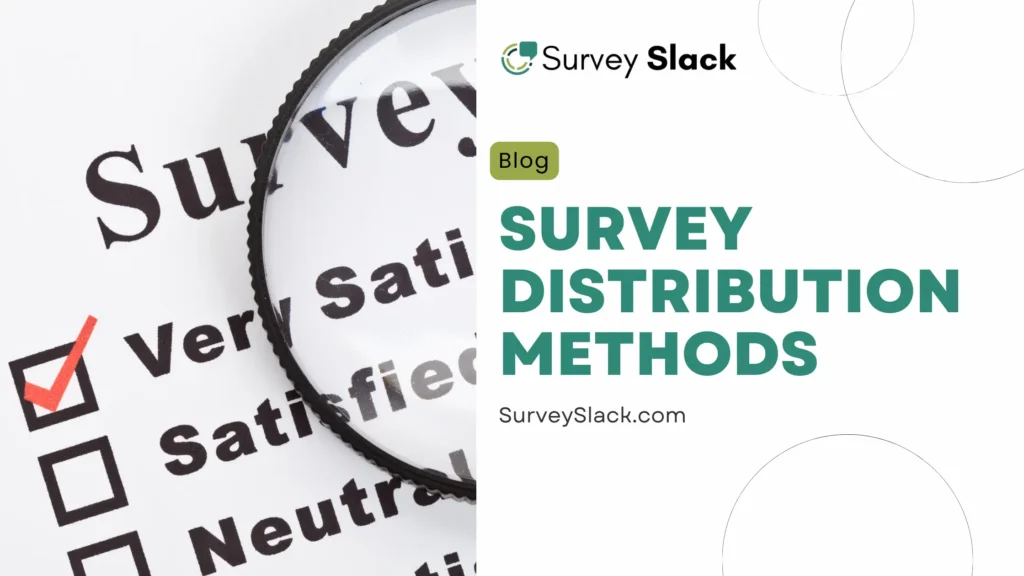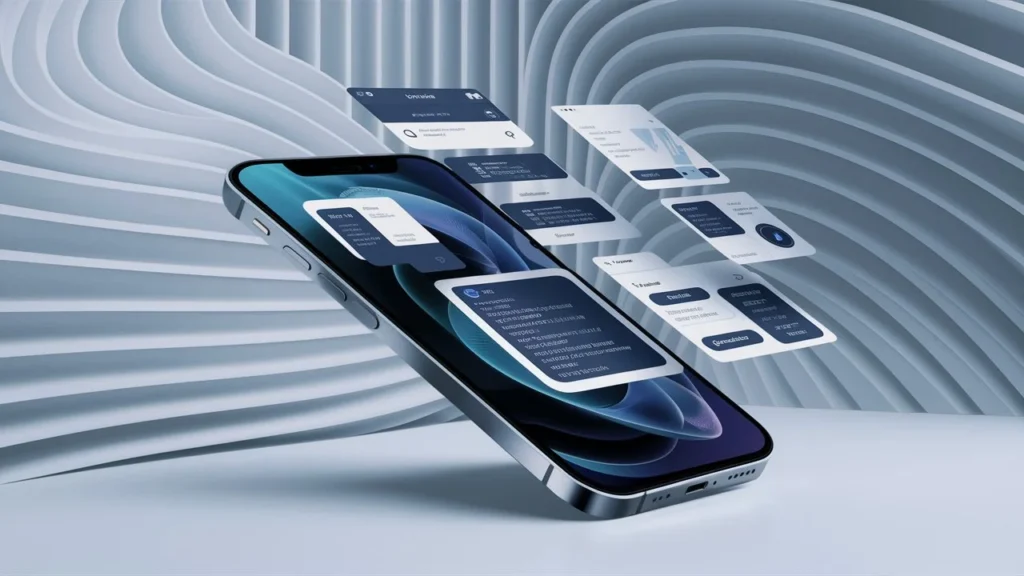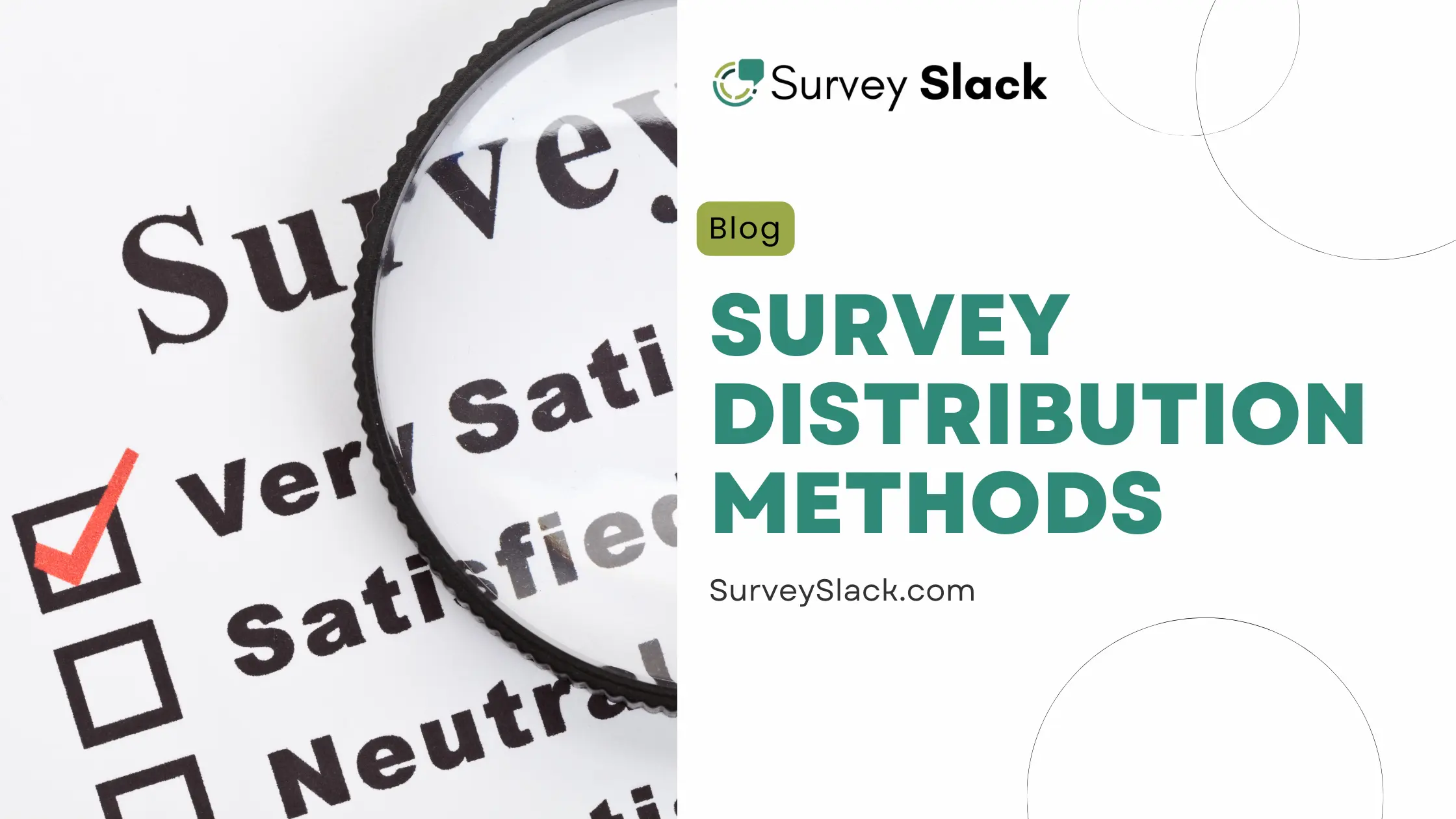Survey Distribution Methods

The key to valuable survey results lies in effective distribution. Choosing the right Survey Distribution Methods to reach your target audience is important. Because it helps you get more people to take part and collect better data.
According to ScienceDirect, the average online survey response rate is around 44.1%. Findings show that adding more people doesn’t always raise the rate. Targeting an exact and relevant audience has a big impact. It improves response rates.
The method you choose depends on your target audience for the survey. It also depends on what’s most convenient for them.
In this article, we’ll explore various online survey distribution methods. They will help you pick the right channels to reach your target audience. They will also collect reliable data. With a free survey maker, you can distribute your survey more effectively and at no cost.
Ditch the Paper, Get Smarter Data
Upgrade your surveys to online forms & get powerful insights. Faster. Easier.
Table of Content
- Understanding Your Audience
- Choosing the Right Channels
- Optimizing Timing and Frequency
- Crafting Compelling Invitations
- Making it Mobile-Friendly
- Tracking and Analyzing Results
- A/B Testing for Improvement
Understanding Your Audience
The key to a successful survey strategy is tailoring it to your audience. You need to match your methods to their specific demographics and habits. By understanding your audience, you can pick the channels they’ll likely engage with. This way, your survey will reach the right people.

Here’s why audience understanding is critical:
- Increased Response Rates: People are bombarded with surveys every day. By targeting the right channels, you increase the chances. Your survey will land with someone interested in participating.
- Reduced Bias: Certain distribution methods skew your sample towards specific demographics. You can use it to choose channels that reach your whole target group.
- Improved Engagement: Tailor the survey to your audience’s preferences. This can lead to more completed surveys and better responses.
Also, Read:
Choosing the Right Channels
Not all surveys are created equal, and the same goes for how you deliver them. Choosing the right channels to distribute your survey is key to reaching the perfect audience and getting valuable data each method has its pros and cons. It is necessary to choose the ones that best fit your audience and research goals. Here’s a breakdown of some popular survey distribution methods channels:

Email:
Email is a top choice for sending surveys. It’s the main way businesses and consumers communicate. To send your survey by email, you’d traditionally include a link in the message. Remember to make a catchy subject line. Keep the email short. Clearly say what you want.
Pros:
- Email is the familiar platform for internal communication in most organizations. Sending surveys through email uses this established channel.
- Employees are already comfortable receiving and replying to work emails. So, it’s a seamless way to gather their feedback.
- Emails allow for easy connection with participants. They can introduce the survey’s purpose and supporting information. Accessible on any device, email is not limited by geography or time zones.
- Participants can also contact the research team for questions. This will enhance their understanding and confidence in completing the survey.
Cons:
- Email marketing lists should be updated and members can opt out if desired.
- The email should provide a clear data collection strategy. It should outline privacy and data management rights.
- Sending unsolicited emails to target customers can breach data security rules. So, review the relevant legislation before sending them.
- With a low response rate (average 20%), spam filters might block emails.
Panel:
This established method helps researchers and marketers reach specific audiences. Companies pay for surveys to be delivered to pre-qualified participants. These participants match their target market’s demographics. This ensures the responses come from the right people. It gives them more weight in the analysis.
Pros:
- Access to a pre-recruited audience, and high response rates.
- Researchers can select from a diverse range of respondents with specific profiles. Panels are also cost-effective.
- They are a traditional method for researchers. They use them when they struggle to find their sample. They can’t find it from their customer database or social media followers.
Cons:
- Third-party services may lack transparency. They can encourage respondents to complete surveys quickly. This could affect the quality of the results.
- It’s crucial to ensure panel providers include data quality checks. These checks remove poor responses and avoid paying for unsuitable data.
- It Can be expensive, and may not always perfectly represent your target audience.
Social Media:
To reach a broad, non-specific audience, consider using social media for survey marketing. Creative strategies include making promo images. They also involve sending alerts on micro-blogging sites. They include recommending the survey to specific people. And, they involve considering survey incentives. Share the survey link from the social media post. Or, share a link to a website for more information and the survey link.
Pros:
- Surveys get high response rates from many market segments. They also increase brand visibility and engagement.
- It’s easy for followers to share the survey, and hashtags enhance visibility. Paid social posts reach a wider audience and increase survey visibility.
- Great for reaching a broad audience, easy to share.
Cons:
- The research team may need to spend money on social media posts. This would help them gain more viewers, but it might increase project costs. Clear information on links is crucial for viewers to find more information.
- You may need to work with social media managers or administrators. This collaboration may be needed to set up a process for feedback and inquiries. Doing this will take time each time someone asks a direct question.
- With limited control over who sees the survey, responses may be less thoughtful.
Website Pop-ups:
Your brand’s active website can effectively share survey questions. They attract customers. The customers see them as feedback opportunities. The customers are likely to answer many questions.
Pros:
- Target visitors already interested in your content. This survey channel targets brand-interested visitors. It allows for specific feedback on product pages.
- Researchers can compare customer behavior with survey responses using cookies and website metrics. Cookies can also target when pop-up surveys should be sent based on customer volume.
- Surveys can start from user events, like clicking away. They gather feedback on specific behaviors, like cart abandonment.
Cons:
- Data security regulations protect IP addresses. They prevent researchers from getting personal visitor details in some regions.
- Pop-ups can be annoying and hinder tasks. So, it’s crucial to use them strategically and limit how often a user can be invited to take a survey.
- Can be intrusive, and may annoy some visitors.
Mobile Apps:
Brands can use their apps as digital channels. They can use them to engage with customers at key moments. Research, Development, and Evaluation (RDE) can request survey participation. It offers incentives, like access to premium beauty tips. The app can also work as a channel. It is similar to a brand’s website. It shares the survey link through pop-ups or messages.
Pros:
- RDE can improve the app user experience. It does this by offering extra time and insights in exchange for theirs.
- This eliminates the need for money and can boost response rates. Apps are mobile-friendly, allowing users to access surveys.
- RDE can be used to gather UX feedback on the app, resulting in higher-quality data.
- Convenient for respondents, high engagement with mobile users.
Cons:
- The survey is limited to app users and may not be suitable for broader research. To expand, consider using mobile in-app surveys. Use them with other methods like websites, social media, and email.
- Participants may not take surveys seriously. They may answer questions quickly for bonuses.
- Results may not have demographics for data segmentation.
- Requires app development or integration, may limit reach to those without the app.
In-person Surveys:
In-person research can help with surveys. It involves participants attending meetings or focus groups. They answer questions and analyze their responses.
Pros:
- Researchers can use verbal and non-verbal cues to understand responses. This makes the survey useful for understanding physical product usage and assessment.
- For instance, identifying user-friendly items from a group can be explored. A group’s presence can encourage open communication. It also encourages sharing among participants.
- High response rates, good for detailed explanations, allow for visual aids.
Cons:
- In-person interviews can lead to conformity bias and biased answers. Participants may be influenced by the researcher or by non-verbal cues.
- Large groups may overtake smaller voices. It may be hard for them to offer disagreeing or sensitive views.
- Data collection from in-person interviews requires transcription, uploading, and analysis. It can be labor-intensive. It needs a powerful analytics tool for counting qualitative data. Time-consuming and expensive to administer, may not be feasible for large populations.
Phone Surveys:
Researchers will schedule interviews with participants. They will speak with participants one-on-one or they will read questions and fill out a survey for them.
Pros:
- Distributing surveys in real-time lets researchers follow up on questions. It also allows them to gather richer data.
- Building rapport through telephone conversations can lead to more nuanced answers.
- This method is best for small to medium groups. It allows research to be done over a set time.
- It’s good for reaching people with no internet. It allows for clarification and follow-up questions.
Cons:
- Phone surveys require much administration. They can cost more for research groups than email or website surveys.
- We must transcribe the data from phone interviews. Then, we upload it to a platform for analysis.
- This process can be labor-intensive. But, it is not if the platform offers voice analytics. They transcribe and analyze conversations in real time.
- Expensive, can be intrusive, declining response rates.
SMS Surveys:
SMS is a great way to distribute surveys. This is due to its high open rate 90% of people open a text within three minutes.
Pros:
- Surveys are easily accessible. This is because SMS and notifications are common in social and work activities.
- However, message space can be limited, so short and compelling messages are essential.
- An integrated survey platform can quickly collect and analyze results. It is not limited by geography or time zones. Longer introductions may not be suitable for this method.
- High open rates, convenient for respondents, good for short and simple surveys.
Cons:
- SMS messages can be considered spam if not linked to an existing contact. It’s crucial to identify the sender and explain the purpose of the communication.
- Keep up-to-date SMS marketing lists. Members should be able to opt-out.
- The plan should provide a clear data collection strategy. It should outline privacy and data rights. Costs depend on the service and message frequency.
- A limited question format, may not be suitable for complex surveys.
Also, Read:
Optimizing Timing and Frequency
Once you’ve picked the right channels to reach your audience. It’s crucial to also think about the best time to send a survey. You must also consider how often to send the survey. Here’s how to maximize your chances of getting high-quality responses:

Timing:
- Day of the Week: Studies suggest weekdays generally yield better response rates than weekends. Tuesdays, Wednesdays, and Thursdays are often considered optimal.
- Time of Day: Early mornings and evenings are better for email surveys. Lunchtime might be best for mobile surveys.
- Social Media: Posting times can vary depending on the platform. Research peak usage times for your target audience on specific social media channels.
Frequency:
- Survey Fatigue: Avoid overwhelming your audience with too many surveys. Space them out strategically to avoid decreasing response rates.
- Follow-up Surveys: For long studies, send follow-up surveys at set times. Use them to track changes. However, ensure a clear justification for follow-up to avoid annoyance.
Also, Read:
Crafting Compelling Invitations

The first impression matters. This is especially true for surveys. With an AI survey questions generator, you can make it possible. A well-crafted invitation can significantly impact your response rate. Here are some key points to be considered:
- Clarity and Conciseness: Keep your invitation message clear and concise. Briefly explain the purpose of the survey and the estimated time for completion.
- Highlighting Benefits: Explain how the respondent’s participation will help the research. Also, say what they can gain from taking the survey.
- Personalization: When possible, personalize the invitation by using the respondent’s name. This can make them feel more valued and increase their likelihood of participating.
- Strong Call to Action: Include a clear call to action, such as “Take the Survey Now” or “Click Here to Participate.”
Also, Read:
Making it Mobile-Friendly
Today’s world is driven by mobile devices. Many online survey distribution responses will likely come from smartphones and tablets. Here’s why ensuring your survey is mobile-friendly is crucial:

- Increased Accessibility: A survey that’s mobile-friendly lets you reach more people. It works on any device.
- Improved User Experience: Surveys that adapt to small screens and touch interactions provide a smoother experience. They are more enjoyable for respondents on mobile devices.
- Higher Completion Rates: Frustration with clunky interfaces or difficult navigation can lead to survey abandonment. A mobile-friendly design reduces these issues and encourages completion.
Here are some key considerations for mobile-friendly surveys:
- Single-column layout: Avoid horizontal scrolling and ensure all content fits comfortably on a single screen.
- Large buttons and clear labels: Make buttons easy to tap and ensure labels are clear and concise.
- Shorter question formats: Opt for shorter questions and answer choices well-suited for touch interaction.
- Fast loading times: Optimize your survey for quick loading on mobile networks. This will avoid drop-off due to slow times.
Choosing the Right Incentive:
The ideal incentive will depend on your target audience and budget. Here are some options to consider:
- Small monetary rewards: Gift cards or small cash payments can be effective without attracting solely reward-seekers.
- Charity donations: Allow respondents to choose a charity to receive a donation on their behalf.
- Entry into a raffle or sweepstakes: Offer a larger prize to a few participants. This will create excitement without costing much.
Also, Read:
Tracking and Analyzing Results
Doing your survey distribution methods is just one step in the research process. To gain valuable insights, you need to effectively track and analyze the results. Here’s why this stage is crucial:

Monitoring Response Rates:
- Identifying Issues: Tracking response rates lets you find any distribution problems. Low response rates might indicate a need to adjust your methods or target audience.
- Gauging Success: High response rates are a good sign. They show that your survey is reaching the right people and generating interest.
Analyzing Completion Times:
- Survey Length: Analyzing how long it takes respondents to finish your survey can help you find long or hard parts. These sections might discourage participation.
- Engagement Levels: Completion times can also show how engaged respondents were.
Using Data to Improve:
By tracking and analyzing your results, you can gather valuable data. You can use it to inform future survey efforts. This data can help you:
- Refine Distribution Strategies: Identify the best channels. Adjust your approach for future surveys.
- Improve Survey Design: Learn from completion times. Find areas where your survey can be made simpler or more engaging.
A/B Testing for Improvement
The world of research is rarely static. Your audience and their preferences evolve. So, your survey methods should too. A/B testing is a powerful tool. It lets you continuously improve your methods and maximize your response rates.

What is A/B Testing?
A/B testing involves making variations of a single element. For example, an email’s subject line or a survey invitation. You then send the variations to different segments of your target audience. By analyzing the results, you can determine which variation performs better.
A/B Testing Survey Distribution:
Here are some elements you can A/B test for survey distribution:
- Subject Lines: Test different subject lines for your email invitations. Check out which gets the most opens.
- Invitation Messages: Compare different versions of your invitation message. See which one suits your audience.
- Distribution Channels: Test different channels. For example, try email and social media. See which one gets the highest response rate for your survey.
- Incentive Types: If you offer incentives, do A/B tests on different incentive types. For example, test entry into a raffle vs a small donation. See which type motivates the most participation.
Get Deeper Customer Insights
Uncover what your customers really think with our user-friendly survey tools
Conclusion
This guide outlines strategies for improving survey distribution methods. They ensure surveys reach the right people and produce reliable data. It emphasizes tailoring methods to demographics. You select channels and schedule for high response rates. It explains the purpose and offers a seamless experience on smartphones and tablets. It also considers incentives monitors response rates and continuously refines distribution methods.





